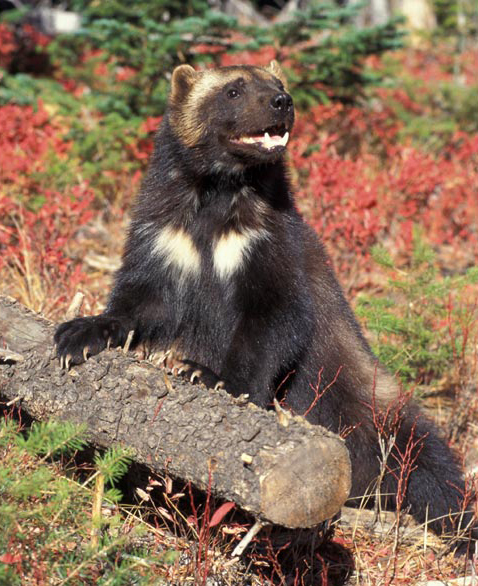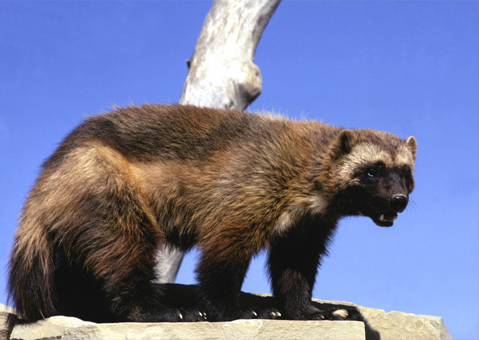June 14, 1805 [14 June 1805], contained, for Meriwether Lewis, a “succession of curious adventures,” which taken together, he wrote, “wore the impression on my mind of inchantment.” He discovered, with mounting wonder, four more falls and numerous rapids and cascades above the “sublimely grand specticle” of the Big Falls he had seen on the thirteenth. There was another dimension to his adventures, too:
In returning through the level bottom of Medecine river and about 200 yards distant from the Missouri, my direction led me directly to an anamal that I at first supposed was a wolf. But on nearer approach or about sixty paces distant I discovered that it was not. Its colour was a brownish yellow; it was standing near it’s burrow, and when I approached it thus nearly, it c[r]ouched itself down like a cat looking immediately at me as if it designed to spring on me. I took aim at it and fired. It instantly disappeared in its burrow. I loaded my gun and examined the place, which was dusty, and saw the track from which I am still further convinced that it was of the tiger kind. Whether I struck it or not I could not determine, but I am almost confident that I did. My gun is true, and I had a steady rest by means of my espontoon, which I have found very serviceable to me in this way in the open plains.
In the next paragraph Lewis referred to it as a “tyger cat.” Could it have been a wolverine instead? Very likely.
Classification
Lewis had never seen an animal like it before, and if it really was a wolverine, his uncertainty is understandable. Even Carl Linneaus,[1]Technically, his last name is Linnaeus, but the web-friendly Linnaeus is used on this page. the father of modern taxonomy (orderly classification in the natural sciences), couldn’t decide whether the wolverine belonged to the weasel family or the dog family, and perhaps for that reason omitted it from his book, Systema naturae, in 1735. But by the time Lewis returned home he could have found it in Noah Webster’s brand-new Compendious Dictionary of the English Language (1806): “Wolverine, n. a carniverous animal, the glutten,” which accounts for its formal scientific name, Gulo gulo—”Glutton-glutten.”
It had long since gained the reputation that suggested its common name by which Webster knew it. An apocryphal passage in an early sixteenth-century book described it as:
an animal which feeds on carcasses and is highly ravenous. It eats until its stomach is as tight as a drumskin, then squeezes itself through a narrow passage between two trees. This empties the stomach of its contents and the wolverine can continue to eat untill the carcass is completely consumed.[2]Quoted in David Macdonald, ed., The Encyclopedia of Mammals (New York: Facts On File, Inc., 1984), p. 120. A comprehensive online discussion of Gulo gulo will be found at The Wolverine Foundation, … Continue reading
Eventually its common name became Latinized as its generic name, Gulo (GOO-lo; Latin for glutton) and, as if there were nothing more to be said, its species designation is gulo also.
Characteristics
Gulo gulo is native to the forests of the world’s boreal latitudes, the North Temperate Zone. The Old World wolverine is officially called Gulo gulo gulo. The North American subspecies is Gulo gulo luscus. The subspecific designation luscus is a Latin term indicating poor vision, or near-sightedness—which may have caused what appeared to Lewis to be an attack stance. Its habitat extends from northern Canada as far south as the Northern Rockies, which is where Lewis may have encountered it. An adult male will be up to 44 inches long, including a seven- to ten-inch tail, and may weigh from 18 to 42 pounds. It makes up for its poor eyesight with excellent senses of smell and hearing. Totally adapted for survival under the severities of life in the extreme northern latitudes, it will eat anything it can find, although it favors carrion, although when it comes down to a survival mode, the wolverine will even feed on wasp nests.[3]Adrian Forsyth, Mammals of North America: Temperate and Arctic Regions (Buffalo, New York: Firefly Books, 1999), 233. Its acute sense of smell enables it to locate leftovers from the predations of lynx, wolves, or grizzly bears, and if their owners are still present, the wolverine is fully capable of driving them away and stealing their meals. To discourage other scavengers from stealing its own caches of carrion, the “skunk bear,” as it is sometimes called, marks them with deposits of foul-smelling musk. When the snow is deep enough to slow down caribou, moose, or elk, its oversized paws serve as snowshoes, enabling it to make its own large-animal kills, which its powerful jaws are well equipped to dismember and devour.[4]John O. Whitaker, Jr., National Audubon Society Field Guide to North American Mammals (rev. ed., New York: Knopf, 1996), 770 -772.
As of 2007 there were only between 200 and 300 wolverines in the continental United States. It is feared that owing to global warming that population will soon diminish close to the point of extinction. The females depend on snowbanks for denning and raising their young, but the snow line is steadily receding up the mountainsides and spring thaw is beginning earlier every year.
Another Close Encounter
On one other occasion Meriwether Lewis mentioned seeing an animal he couldn’t identify, or clearly associate with any species he knew, and which, because he saw it so fleetingly, he was unable to describe in sufficient detail for us to ascertain its identity.
On 12 August 1805, in the vicinity of Lemhi Pass—the divide between the Missouri and Columbia River drainages, and still within what today is the normal range of the wolverine—Lewis wrote:
We saw an animal which we took to be of the fox kind, as large or reather larger than the small wolf of the plains [coyote]—its colours were a curious mixture of black, redish brown and yellow. Drewyer [interpreter and hunter George Drouillard] shot at him about 130 yards and knocked him down, but he recovered and got out of our reach.
We may interpret his assertion that “it is certainly a different animal from any that we have yet seen” to mean it definitely was not the same as the one he shot at two months earlier from a distance of only sixty paces, or about thirty yards. But what could it have been?
Speculation has brought up several possibilities. Elliott Coues, who in 1892 commented extensively on Biddle’s paraphrase of the original journals, footnoted both events with the remark that it was “probably the wolverine or carcajou, Gulo luscus.” Reuben Gold Thwaites, editor of the first publication of the original journals (1904), thought the animal Lewis encountered on June fourteenth might have been a wolverine or—perhaps granting Lewis the benefit of the doubt—a cougar. But judging from photographs, which is certainly easier than drawing conclusions after a fleeting glance at some distance in the wild, the wolverine looks more like a species of bear than either a “small wolf of the plains” or a wild feline. Journal editor Gary Moulton suggests both critters were wolverines.
Notes
| ↑1 | Technically, his last name is Linnaeus, but the web-friendly Linnaeus is used on this page. |
|---|---|
| ↑2 | Quoted in David Macdonald, ed., The Encyclopedia of Mammals (New York: Facts On File, Inc., 1984), p. 120. A comprehensive online discussion of Gulo gulo will be found at The Wolverine Foundation, http://www.wolverinefoundation.org/ |
| ↑3 | Adrian Forsyth, Mammals of North America: Temperate and Arctic Regions (Buffalo, New York: Firefly Books, 1999), 233. |
| ↑4 | John O. Whitaker, Jr., National Audubon Society Field Guide to North American Mammals (rev. ed., New York: Knopf, 1996), 770 -772. |


